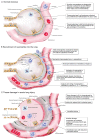Contribution of neutrophils to acute lung injury
- PMID: 21046059
- PMCID: PMC3060975
- DOI: 10.2119/molmed.2010.00138
Contribution of neutrophils to acute lung injury
Abstract
Treatment of acute lung injury (ALI) and its most severe form, acute respiratory distress syndrome (ARDS), remain unsolved problems of intensive care medicine. ALI/ARDS are characterized by lung edema due to increased permeability of the alveolar-capillary barrier and subsequent impairment of arterial oxygenation. Lung edema, endothelial and epithelial injury are accompanied by an influx of neutrophils into the interstitium and broncheoalveolar space. Hence, activation and recruitment of neutrophils are regarded to play a key role in progression of ALI/ARDS. Neutrophils are the first cells to be recruited to the site of inflammation and have a potent antimicrobial armour that includes oxidants, proteinases and cationic peptides. Under pathological circumstances, however, unregulated release of these microbicidal compounds into the extracellular space paradoxically can damage host tissues. This review focuses on the mechanisms of neutrophil recruitment into the lung and on the contribution of neutrophils to tissue damage in ALI.
Figures
References
-
- Bernard GR, et al. The American-European Consensus Conference on ARDS. Definitions, mechanisms, relevant outcomes, and clinical trial coordination. Am J Respir Crit Care Med. 1994;149:818–24. - PubMed
-
- Ware LB, Matthay MA. The acute respiratory distress syndrome. N Engl J Med. 2000;342:1334–49. - PubMed
-
- Ware LB. Pathophysiology of acute lung injury and the acute respiratory distress syndrome. Semin Respir Crit Care Med. 2006;27:337–49. - PubMed
Publication types
MeSH terms
LinkOut - more resources
Full Text Sources
Other Literature Sources


